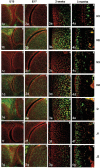The distribution of Notch receptors and their ligands during articular cartilage development
- PMID: 12846471
- PMCID: PMC1571106
- DOI: 10.1046/j.1469-7580.2003.00185.x
The distribution of Notch receptors and their ligands during articular cartilage development
Abstract
We examined the distribution of Notch family members and their ligands during the development of articular cartilage and the growth plate. Notch 1 was expressed by the chondrocytes of the developing articular surface but became increasingly restricted to the deeper layers after birth whilst expression of this family member was restricted to hypertrophic chondrocytes in the growth plate. Notch 2 and 4, Delta and Jagged 2 showed a broadly similar distribution, being present throughout the articular cartilage during development and becoming increasingly restricted to deeper layers with age. Hypertrophic chondrocytes within the growth plate also expressed Notch 2 and 4, Delta and Jagged 2 (which was also expressed in prehypertrophs). Notch 3 and Jagged 1 were absent from developing articular cartilage but were present in deeper layers at later time points (> 1 month) and both receptor and ligand were expressed in hypertrophic chondrocytes at all ages examined. These results highlight the complex Notch signalling interactions that result in the formation of the heterogeneous articular cartilage and allow for the co-ordinated ossification and elongation of the growth plate. Mechanisms by which these processes are controlled are discussed in light of recent advances in the understanding of Notch signalling pathways.
Figures









Similar articles
-
Notch receptor and Notch ligand expression in developing avian cartilage.J Anat. 2009 Aug;215(2):159-69. doi: 10.1111/j.1469-7580.2009.01089.x. Epub 2009 May 28. J Anat. 2009. PMID: 19490397 Free PMC article.
-
Expression pattern of notch1, 2 and 3 and Jagged1 and 2 in lymphoid and stromal thymus components: distinct ligand-receptor interactions in intrathymic T cell development.Int Immunol. 1999 Jul;11(7):1017-25. doi: 10.1093/intimm/11.7.1017. Int Immunol. 1999. PMID: 10383933
-
Cortisol regulates the expression of Notch in osteoblasts.J Cell Biochem. 2002;85(2):252-8. doi: 10.1002/jcb.10125. J Cell Biochem. 2002. PMID: 11948681
-
Notch receptors and hematopoiesis.Exp Hematol. 2001 Sep;29(9):1041-52. doi: 10.1016/s0301-472x(01)00676-2. Exp Hematol. 2001. PMID: 11532344 Review.
-
Notch signaling in vascular development.Arterioscler Thromb Vasc Biol. 2003 Apr 1;23(4):543-53. doi: 10.1161/01.ATV.0000060892.81529.8F. Epub 2003 Feb 13. Arterioscler Thromb Vasc Biol. 2003. PMID: 12615665 Review.
Cited by
-
Transient activation of Wnt/{beta}-catenin signaling induces abnormal growth plate closure and articular cartilage thickening in postnatal mice.Am J Pathol. 2009 Nov;175(5):1993-2003. doi: 10.2353/ajpath.2009.081173. Epub 2009 Oct 8. Am J Pathol. 2009. PMID: 19815716 Free PMC article.
-
The role of the Notch pathway in healthy and osteoarthritic articular cartilage: from experimental models to ex vivo studies.Arthritis Res Ther. 2011 Mar 18;13(2):208. doi: 10.1186/ar3255. Arthritis Res Ther. 2011. PMID: 21457519 Free PMC article. Review.
-
Structure and Functions of HMGB2 Protein.Int J Mol Sci. 2023 May 5;24(9):8334. doi: 10.3390/ijms24098334. Int J Mol Sci. 2023. PMID: 37176041 Free PMC article. Review.
-
Anti-osteoarthritis effect of a combination treatment with human adipose tissue-derived mesenchymal stem cells and thrombospondin 2 in rabbits.World J Stem Cells. 2019 Dec 26;11(12):1115-1129. doi: 10.4252/wjsc.v11.i12.1115. World J Stem Cells. 2019. PMID: 31875872 Free PMC article.
-
Niches for Skeletal Stem Cells of Mesenchymal Origin.Front Cell Dev Biol. 2020 Jul 10;8:592. doi: 10.3389/fcell.2020.00592. eCollection 2020. Front Cell Dev Biol. 2020. PMID: 32754592 Free PMC article. Review.
References
-
- Archer CW, Boyer S, Redman S, Bishop J, Dowthwaite GP. The identification and characterisation of articular cartilage progenitor cells. Trans. ORS. 2002;48:9.
-
- Artavanis-Tsakonas S, Matsuno K, Fortini ME. Notch signalling. Science. 1995;268:225–232. - PubMed
-
- Bayliss MT, Osborne D, Woodhouse S, Davidson C. Sulfation of chondroitin sulfate in human articular cartilage. The effect of age, topographical position and zone of cartilage on tissue composition. J. Biol. Chem. 1999;274:15892–15900. - PubMed
-
- Campos AH, Wang W, Pollman MJ, Gibbons GH. Determinants of notch-3 receptor expression and signalling in vascular smooth muscle cells: implications in cell cycle regulation. Circ. Res. 2002;29:999–1006. - PubMed
MeSH terms
Substances
LinkOut - more resources
Full Text Sources
Molecular Biology Databases

